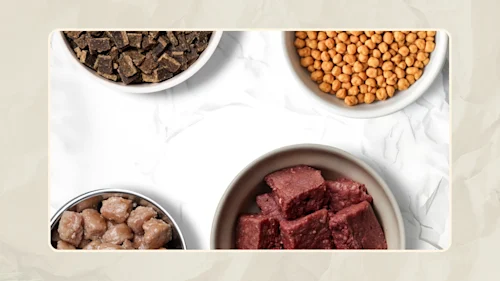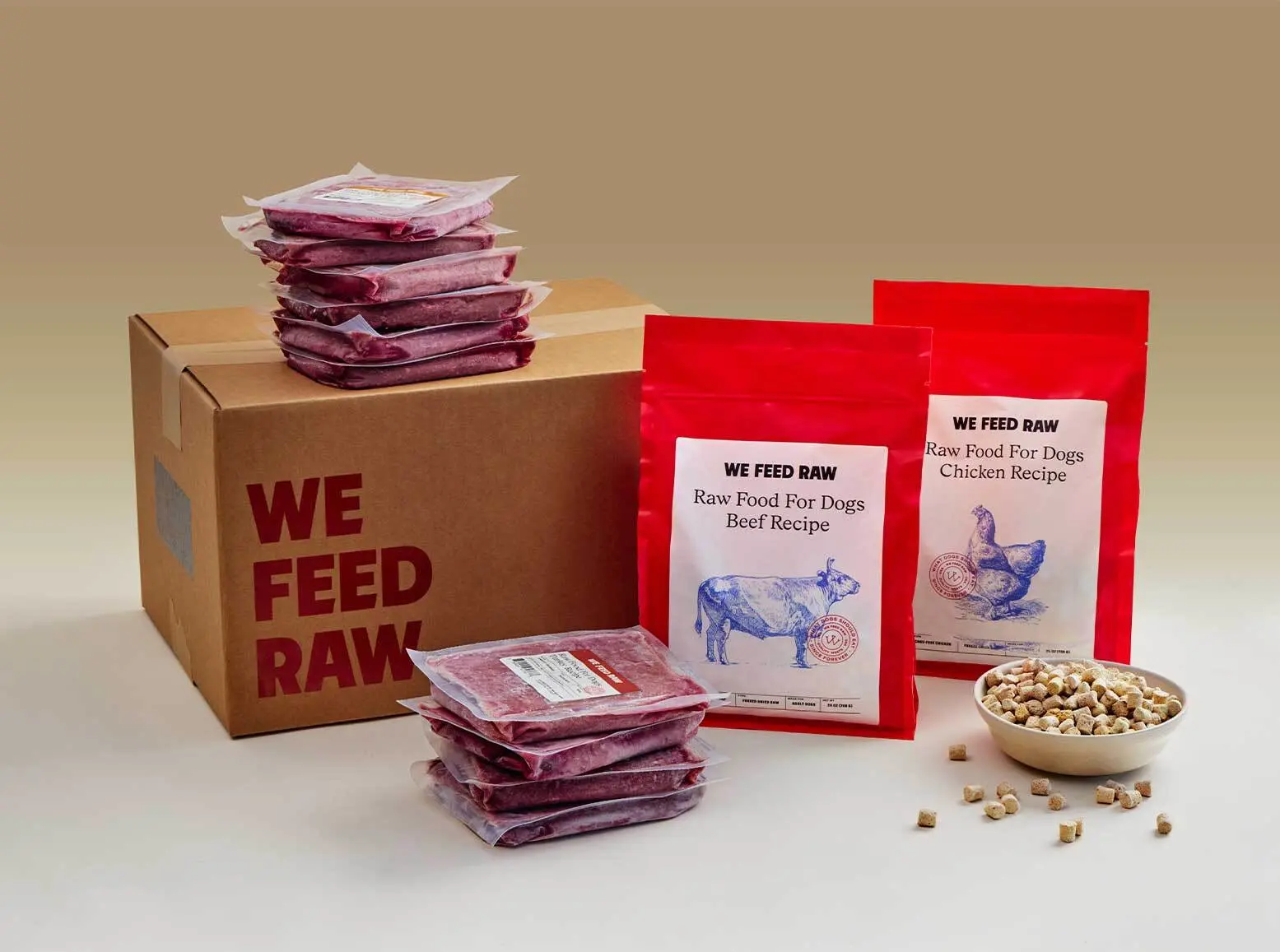
Is Raw Food Better for Dogs? Ranking the Best and Worst Diets
Table of Contents
- The Gold Standard: Biologically Appropriate Raw Diets
- Better, But Not the Best: Minimally Processed Alternatives
- The Downward Slide: Processed and Carb-Heavy Choices
- The Bottom of the Bowl: Canned & Semi-Moist Foods
- Why Raw Definitively Answers: Is Raw Dog Food Better Than Kibble?
- Final Verdict: We Feed Raw Is the Right Choice
- Frequently Asked Questions (FAQs)
Walking down the dog food aisle can feel overwhelming. Pet parents face an endless array of options—dry kibble, canned mush, gently cooked, freeze-dried, and raw—all claiming to be the "best." How do you know what will actually nourish your pup and support their long-term health?
This comprehensive guide eliminates the guesswork from dog food selection. We definitively answer the question, "Is raw food better for dogs?" by ranking every major diet from worst to best.
We will show you why a raw diet is better for dog dental care and identify the best dog food alternatives to kibble.
The Gold Standard: Biologically Appropriate Raw Diets
When it comes to canine nutrition, biologically appropriate raw diets reign supreme. This food mimics what dogs are evolutionarily designed to eat. This makes it the gold standard for providing nutrients in their most natural and bioavailable form.
Cold-Pressurized Frozen Raw
Cold-pressurized frozen raw food is the optimal choice. It consists of high-quality, USDA human-grade meat, nutrient-rich organs, and bone.
We make our food safe by using high-pressure processing (HPP) before freezing the ingredients. This process is essential for safety, helping to inactivate potentially harmful bacteria and viruses without compromising nutritional integrity.
This format most closely resembles the moisture-rich, natural prey of wild canines.
Freeze-Dried Raw
Freeze-dried raw is an excellent counterpart to frozen raw. This format removes moisture from the raw ingredients through sublimation, resulting in a lightweight, shelf-stable product. It retains nearly all the nutritional value of frozen raw food and is a great option for travel, hiking, or as a convenient topper for a kibble diet.
Safety Differentiator: High-Pressure Processing (HPP)
A key factor separating premium raw brands from others is safety. We implement strict safety protocols, including pathogen testing and control measures, to ensure our products are safe. High-pressure processing (HPP) is our scientifically validated method that further enhances safety by eliminating pathogens, while maintaining the food's raw nutritional benefits.
Better, But Not the Best: Minimally Processed Alternatives
Moving down the spectrum, we find foods that are better than traditional kibble but still fall short of the nutritional powerhouse that is a raw diet.
Gently Cooked Foods
Gently cooked foods are made with fresh, whole-food ingredients cooked at lower temperatures than traditional methods. These recipes are typically refrigerated to maintain freshness.
•Pros: They are less processed than kibble and canned food. The high moisture content is a significant advantage over dry food.
•Cons: Even gentle cooking alters the structure of proteins (denaturation) and leads to the degradation of some essential nutrients, particularly heat-sensitive vitamins and enzymes.
Air-Dried and Dehydrated Foods
Air-dried and dehydrated foods represent a middle ground, offering more whole ingredients than kibble but still involving heat treatment that impacts their nutritional profile.
•Pros: They generally contain less starch than kibble, and air-dried foods, in particular, can retain more natural enzymes. They are shelf-stable and highly convenient.
•Cons: Low-heat exposure still compromises some nutritional value, especially heat-sensitive vitamins. The removal of moisture reduces natural hydration and alters the food's texture.
The Downward Slide: Processed and Carb-Heavy Choices
These options offer the least nutritional value and are often misleadingly marketed as being complete and healthy.
Dry Kibble
Kibble is the most common food type, yet it offers the least species-appropriate nutrition.
•The Problem: The high-heat extrusion process drastically reduces the bioavailability of nutrients. Essential enzymes and vitamins are often destroyed, requiring synthetic supplements to be added back.
•The Misconception: Kibble is dense with carbohydrates, which are necessary to bind the pellets together. This high carbohydrate content is unnatural for a dog's carnivorous biology and contributes to obesity, inflammation, and dental issues.
Raw-Coated Kibble
Raw-coated kibble is simply dry kibble that has been sprayed with a thin layer of raw meat or other raw ingredients after processing. The raw coating does not negate the negative effects of the highly processed, carb-heavy kibble underneath.
This option is primarily a marketing tactic and does not offer the same nutritional benefits as a truly raw diet.
The Bottom of the Bowl: Canned & Semi-Moist Foods
At the very bottom of the dog food ranking, we find canned and semi-moist foods, which represent the most highly processed and often least nutritious choices.
Canned Food
Canned dog food is sterilized through prolonged cooking at very high temperatures. This high-heat cooking destroys many essential nutrients, including vitamins, enzymes, and some amino acids.
Although it has high moisture, this benefit often does not outweigh the nutritional destruction and the likelihood of added fillers and thickeners.
Semi-Moist Foods
Semi-moist dog food achieves its soft, chewy texture through the addition of humectants and other chemical additives. These foods are often loaded with artificial colors, flavors, and preservatives.
They frequently contain excessive amounts of sugar and are notorious for having the lowest nutritional value among all dog food types.
Why Raw Definitively Answers: Is Raw Dog Food Better Than Kibble?
When comparing processed foods to raw, the difference is stark. Raw is the clear winner because it supports a dog's biology:
•Digestibility and Bioavailability: Is raw dog food better than kibble? Yes, because its minimal processing maintains the food's natural structure, making nutrients easier for a dog's body to absorb and utilize. Kibble makes a dog's body work harder for fewer usable nutrients.
•Carb-Free vs. Carb-Heavy: Raw diets are naturally protein-dense and carb-free, aligning with a dog's carnivorous needs. Kibble is high in carbohydrates, providing fuel that leads to inflammation and weight gain.
Ultimately, choosing a biologically appropriate raw diet is the single best way to maximize your dog's health and vitality.
Final Verdict: We Feed Raw Is the Right Choice
We have explored the entire world of dog food choices, and the conclusion remains the same: a biologically appropriate raw diet is the gold standard for canine health. It is the best answer to the question, “Is raw food better for dogs?”
Our commitment to safety through high-pressure processing (HPP) and PhD animal nutritionist-formulated recipes ensures you get the benefits of raw feeding without any of the risks.
Ready to upgrade your dog's diet? Complete our quiz now to discover why We Feed Raw is the best choice for your pup.
Frequently Asked Questions (FAQs)
Is raw food better for dogs because of nutrient bioavailability?
Yes, raw food generally provides superior nutrient bioavailability compared to cooked or extruded diets. Because we use minimal processing and cold-pressure processing (HPP), the natural enzymes, vitamins, and amino acids in the meat remain intact.
This means your dog's body can absorb and utilize those nutrients far more efficiently than it can from high-heat processed food.
Is raw dog food better than kibble for dogs with allergies or sensitivities?
Yes, raw dog food is better than kibble for dogs with sensitivities. We eliminate common inflammatory ingredients found in kibble, such as corn, wheat, soy, and excessive carbohydrates.
Raw food's limited, species-appropriate ingredients reduce the overall burden on the immune system, often leading to a significant reduction in allergy symptoms and digestive issues.
What dog food alternatives to kibble are available if I am on a budget?
Several dog food alternatives to kibble offer better nutrition, even if you are on a budget. Gently cooked food is a good alternative as it undergoes less processing than kibble.
You can also mix a small amount of our raw patties into your dog's existing food, as some raw nutrition is always better than none, helping to boost nutrient density cost-effectively.
Is raw dog food better than kibble in terms of food safety and recalls?
Yes, raw dog food is better than kibble regarding safety, despite common misconceptions. Historically, kibble is far more often the subject of large-scale recalls due to pathogenic contamination than commercially prepared raw food.
We ensure safety by using high-pressure processing (HPP), a validated step that eliminates pathogens without relying on high heat.
Why is raw food better for dogs than both canned and semi-moist options?
Raw food is better for dogs than canned and semi-moist options because it lacks the unnecessary processing and artificial ingredients found in those foods.
Canned foods use extreme heat for sterilization, destroying essential nutrients. Semi-moist foods often contain high levels of sugar, humectants, and fillers, offering very low nutritional value compared to our protein-dense, minimally processed raw meals.
What is the fundamental difference between raw food and other dog food alternatives to kibble, like fresh-cooked food?
The fundamental difference between raw food and other dog food alternatives to kibble, like fresh-cooked food, lies in enzymes. Fresh-cooked foods lose vital enzymes and nutrients to heat, however gentle the cooking is. Our raw food maintains its full spectrum of natural enzymes and nutrient structure, providing the most biologically appropriate and natural diet possible.

Our Meals Change Lives.
(Theirs + Yours.)
See health improvements from our raw meals in as little as 1 week.
